by Winding Pathways | Nov 22, 2018 | Garden/Yard, Geology/Weather, Nature

Glacial rocks arrive at Winding Pathways.
A modern glacier visited Winding Pathways in October.
Our area of Iowa doesn’t have much rock. There’s limestone bedrock in some places. Over the top is a thick layer of subsoil and topsoil with one exception. Glacial erratics.
Thousands of years ago the Upper Midwest was a cold world. Summers were so frigid that the previous winter’s snow didn’t melt. It packed down on top of previous winter’s snow and formed ice. Thick ice is fluid. It moves. Slowly. But it moves. Up in today’s Minnesota, glaciers scooped up granite and other rocks and gave each one a grand, if pokey, ride. As the ice inched forward, often southward, it carried rocks. Often they churned along the bottom of the ice, gradually rounding off like pebbles in the ocean surf do.
Fifteen or twenty thousand years ago the climate warmed. Ancient climate change. Instead of expanding, glaciers shrank, leaving their stone cargo in place, often hundreds of miles from where they were scooped from the ground.
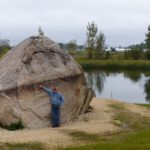
This massive erratic is the centerpiece of a new Marion, IA, park.
It’s complicated because there were several glacial periods of warming and cooling. Sometimes a new glacier picked up and moved rocks left by earlier ice sheets thousands of years earlier. The last glacier to visit Iowa melted about 12,000 years ago, leaving erratics here and there in the prairie that was converted to farm fields. Two of the most renowned glacial erratics in Eastern Iowa are Waldo’s Rock in Marion, and Bever Park’s boulder that generations of kids have climbed.
At Winding Pathways, we needed a retaining wall and first considered using manufactured concrete blocks. Then, we met Cody Rossman of Hardscapes. His business crafts glacial erratics into retaining walls. It’s not easy. Those hunks of rounded granite are heavy.
Cody’s crew brought truckloads of erratics to our yard from where the last glacier abandoned them near Troy Mills, Iowa. It took a husky truck about 45 minutes to bring the rocks 24 miles. That’s nearly 30 miles an hour.
It’s not certain how fast glaciers moved rocks, but it was slow. It could have taken years, decades, or even centuries for ice to move our rocks 24 miles. A speedy glacier might move a rock a mile a decade. Maybe a mile a century. Cody’s method was faster.
The wall’s in place. Every time we look at the rocks we wonder about their travel. Probably they originated in Minnesota hundreds of thousands of years ago to end up preventing erosion in our yard. What stories they could tell? Winding Pathways will find out in a few weeks when retired geologist, Ray Anderson visits and inspects the rocks and shares their stories.
Our wildlife also loves the rocks. A chpmunk popped up between two rocks as soon as the work crews left for the day. The uneven rock surfaces and the nooks and crannies between them provide safe living spaces for our chipmunks and garter snakes.
-
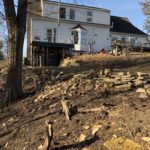
-
View of the old wall.
-
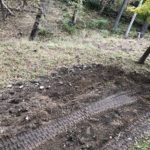
-
The old retaining wall material was removed first.
-
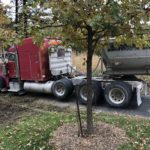
-
Glacial rocks arrive.
-

-
Sorting the rocks.
-
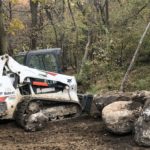
-
Bobcat moves rocks.
-
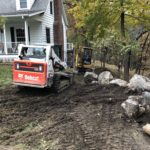
-
The rock wall takes shape.
-
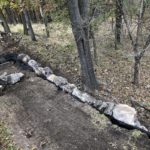
-
After excavating, geotextile is placed and glacial rocks arranged.
-
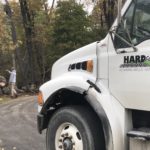
-
Hardscapes crew surveying the project.
-
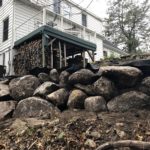
-
The rock wall is firmly in place.
-
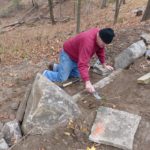
-
Limestone slabs are perfect for making steps.
-
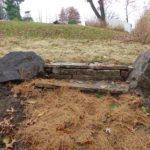
-
Milestone steps into the natural area.
-
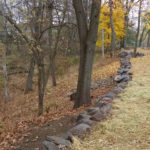
-
Straw protects grass seed and soil from eroding.
by Winding Pathways | Nov 15, 2018 | (Sub)Urban Homesteading, Bugs, Flowers/Grasses, Garden/Yard, Garden/Yard, Nature
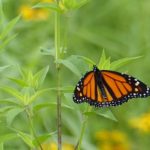
Butterfly on plant
This past summer we enjoyed watching many monarch butterflies flutter over our prairie labyrinth. Numbers were way up from last year.
These intrepid insects are now en route to wintering grounds in Mexico. We look forward to their return next year.
Monarchs suffered huge population declines due to varied stresses on their lives. In farm country, most fencerows, waterways, and pastures that once harbored milkweed and wildflowers that provided both caterpillars and adults with food have disappeared. Today’s farmland is a pesticide-laced monoculture of just a few crops.
In town, manicured and sprayed lawns are as devoid of diversity as a cornfield and can’t sustain beautiful wildlife like butterflies.
The news would be more distressing had people not responded with enthusiasm to the monarchs’ decline. This summer we were delighted to see dozens of homeowners in Cedar Rapids and other towns let their lawns grow taller. Many planted pollinator patches in even tiny yards that include a diversity of native plants, including milkweeds. We took joy in seeing a small patch of milkweeds nurtured by the staff of a convenience store in a tiny patch of dirt near the gas pumps.
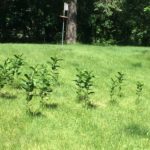
Grow a wild patch on your lawn to encourage butterflies.
Every pollinator patch, even if tiny, adds beauty and diversity to our world. We urge everyone to assist wildlife by creating natural plantings, even in urban areas.
Many Iowans have been inspired by the Monarch Zones Project. Founded by Clark McLeod, the Project provides workshops, encouragement, equipment, and seeds to help people assist this beautiful insect and hundreds of other beneficial species that add richness to our lives and health to the environment.
Next spring’s planting season isn’t far off. Now’s a fine time to plan to expand or create a pollinator patch in the yard. For help contact Monarch Research Project. Let’s continue to work together to create wondrous yards.
Bon voyage, Monarchs!
by Winding Pathways | Nov 8, 2018 | Birds, Nature, Reflections/Profiles, Travel/Columns
A tiny migrating warbler changed my life. As I sat on my back deck a few springs ago a tiny bird landed on a twig about ten feet in front of me. I could see it singing but couldn’t hear a thing.
Military Training and Hearing Loss
My hearing loss probably started as an Army trainee in the late ‘60s guiding 50 caliber shells into a machine gun. Every time the gun spit a bullet downrange a massive blast of noise and pressure hit my skull. In later years I spent hours running chainsaws, vacuum cleaners, and lawn mowers. All to the detriment of my hearing.
Hearing loss is an insidious stealthy condition. It crept up on me so slowly and gradually that I never noticed it. My wife certainly knew something was going on as I increasingly asked her, and everyone else, to repeat sentences. Conversation in restaurants became challenging and tinnitus, or ringing in the ears, became my constant companion. Night and day my ears never stop buzzing.
Call to Action

Fitting hearing aids is a process and building a relationship
Seeing, but not hearing, the warbler spurred me to call Dr. Jennifer Reekers at Heartland Hearing Center in Hiawatha, Iowa. Soon I was sitting opposite her in a hearing test booth that confirmed what I already Low-frequency sounds were easy to distinguish but my ability to detect other sounds dropped as high frequency increased. Dr. Reekers shared good news. Thanks to modern technology she could improve my ability to hear and reduce the pesky tinnitus.
Shortly after receiving my new hearing aids I hiked a six-mile trail to Hanging Rock overlook at Effigy Mounds National Monument. Along the trail, I was serenaded by warblers and Orioles. In a moist trailside valley nature’s most beautiful sound brought me joy. It was the first time I’d heard a wood thrush since my hearing declined.
Everyday Sources of Hearing Loss
Millions of Americans suffer hearing loss, often caused by loud noise exposure. Although most people realize that gunshots and fireworks can cause hearing problems, few recognize that exposure to common everyday lower intensity noise causes gradual hearing loss. Vacuum cleaners, blenders, coffee grinders, lawn mowers, leaf blowers, and the dreadfully loud hand dryers in public restrooms can contribute to a permanent hearing loss. Damage is cumulative.
Prevention!
Solutions exist! The best, by far, is to prevent hearing loss by protecting the ears from loud noise. Inexpensive muffs and plugs mute the scream of vacuum cleaners and power tools. I keep a pair by every noisy machine and always put them on before pushing the start button. Rather than allowing a restroom hand dryer I keep a clean handkerchief in my pocket and use it to dry my hands. Parents should be especially careful to protect their children’s hearing by choosing quiet toys over shrill ones and making sure kids wear muffs when exposed to noise.
Ironically enjoying music can contribute to hearing loss. Many concerts are at such a high decibel level that even short exposure can lead to lifelong hearing problems. Fortunately, devices are available from audiologists that reduce the volume of noise entering the ear while retaining sound quality. They enable enjoyable safe listening.
Technology to the Rescue
By the time I recognized my hearing loss, it was too late to prevent it, but the hearing aids restored my ability to distinguish sounds. I will probably always have tinnitus, but technology has diminished its impact. These days I’m careful to muffle loud noise to avoid further damaging my hearing.
Thanks to Dr. Reekers my hearing aids help me enjoy conversation, birds, music, and more of life’s delightful sounds. I encourage everyone to protect their hearing from loud noise and to seek the help of an audiologist to improve their ability to distinguish sounds.
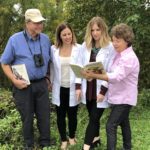
Birding again is a joy with hearing aids, thanks to Heartland Hearing
by Winding Pathways | Oct 25, 2018 | (Sub)Urban Homesteading, Flowers/Grasses, Garden/Yard, Garden/Yard, Nature, Reflections/Profiles
“It was amazing! Gorgeous! Fireflies danced over our prairie most of the summer, and they weren’t here when it was a mowed lawn,” said Katie Hill with much enthusiasm
She and her husband Tim are restoring an island of ecological health just three miles from downtown Cedar Rapids, Iowa. First Avenue is one of the busiest urban streets in Iowa, constantly filled with cars, motorcycles, and trucks. A bald eagle flying over the road would look down at an urbanized landscape – except for five acres of verdant beauty just a few feet east of the Avenue. The oasis is nestled between suburban developments, a high-rise condominium, and a senior residence complex.
Katie and Tim bought three and a half acres and a home about 15 years ago. It was convenient to his work at a law office a stone’s throw from their land. “We did the standard expected landscaping of mowing and spraying for about a decade,” she said.
Creating Habitat
Although the yard was large it lacked plant diversity and wildlife. Then came the change.
“We stopped spraying and I took delight when creeping Charlie and dandelions took hold. Many people don’t like them, but creeping Charlie has a gorgeous flower that bumblebees love, and it smells nice. Dandelions are beautiful, and bees love them,” she said. Then she broadcast prairie seed on a low area that had been lawn. After a couple of years big bluestem, Indian grass, and many native flowers appeared. Encouraged by their first prairie the Hill’s planted new ones in formerly mowed and sprayed lawns. They’ve been helped by David Novak, owner of a small company that helps people restore natural areas.
“We were delighted when lightning bugs appeared over the prairie. They don’t like mowed lawn but love taller plants. We watch them dance on summer evenings. These beautiful insects completely avoid the mowed lawns of our neighbors,” Tim and Katie remarked.
Early in 2018, the Hills bought about an acre and a half of land adjoining their property Years before several houses stood on the property but it had been purchased by a developer who planned to build two condominium towers. He razed the houses and built one condo tower but abandoned plans to build the second.
Restoring the Land
As we walked through the area Katie showed us her new prairie plantings in what had once been a lawn while Tim pointed out where the houses had stood. As the years go by the residents of the existing condominium tower will gaze downward during the day on wildflowers dancing in the breeze and butterflies sipping nectar from prairie blooms. As twilight approaches, they’ll enjoy fireflies blinking their tiny lights.
In addition to creating beauty and feeling the joy of making the earth healthier, the Hills are benefiting the community beyond their property. Prairie grasses absorb stormwater that once sheeted off their land and into storm sewers and eventually Cedar Lake. Their land nurtures wildlife as its beauty increases and diversifies.
“We feel good about what we are doing. We are helping nature restore itself in the heart of the city, but it also does one other thing. When we were mowing and spraying it was costing us about $600 a month to maintain the property. Now that’s dropped to about 90 bucks, so we’re saving money,” the Hills explained.
In the process of restoring their land, Tim and Katie Hill are also getting a fulfilling ecological education.
Win! Win! Win!
“It’s a win, win, win,” smiled Katie. “It’s a win for us saving money. It’s a win for us to have the time to be entertained by the wildlife diversity. And, most importantly, it’s a win for Mother Nature.”
-
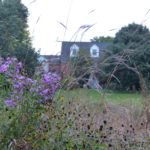
-
New England Asters grace the prairie.
-

-
Butterflies have flocked to the Hill’s property.
-
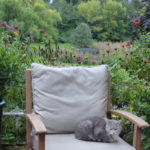
-
One of their many cats relaxes on the patio.
-
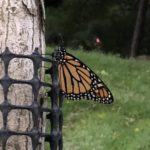
-
A Monarch perches in the lee of a tree resting before leaving for the south.
-

-
Owners of an urban oasis.
-
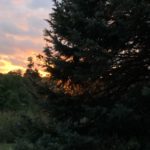
-
Beautiful sunset.
by Winding Pathways | Sep 27, 2018 | Bugs, Nature, Pests
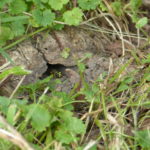
Yellow Jackets work the day shift.
We were recently concerned to find a Yellow Jacket nest close to our front door. Normally we appreciate their ambitious work catching insect prey. If they had made their nest in an out of the way place, we would have left them alone. But, their nest location invited painful stings to us or visitors. They had to go.
Several species of Yellow Jackets live in the United States. Most make an underground nest that can have an opening on the soil surface upwards of an inch in diameter. It can be nearly anywhere, but the nest we found was beneath the lawn next to the walkway into the house.
Yellow Jacket queens overwinter and begin laying eggs in the spring. By late summer or fall, the few Yellow Jackets that were around in spring have multiplied into colonies that can have hundreds of individuals. The workers die in late fall.
Many people discover a Yellow Jacket nest when they walk by it or mow the lawn over the entrance. Angry insects instantly attack and often a hapless person is stung many times in a second or two. Stings really hurt. It’s happened to us more than once, so now we don’t tolerate a nest near the house.
We only kill a Yellow Jacket colony if it’s located where we, or visitors, might be stung. Here’s how we do it:
Yellow Jackets work the day shift. Although they sometimes are out flying in the early evening by dark the entire colony is home underground in the nest. The nest entrance is easily spotted during the day by dozens of Jackets coming and going. We note its location. After dark we approach with a flashlight, spray can of insect killer, and a piece of cardboard, a board, or an old hunk of carpet. The flashlight helps find the hole. We spray a generous amount of poison down the hole, cover it with the carpet, board, or cardboard and weight it down with a rock. The covering keeps the spray in the nest.
The next morning, we watch for Yellow Jacket activity. Usually, there is none, telling us we destroyed the colony. We remove the covering, but if we see some Yellow Jackets we respray at night and cover the nest again. That usually solves the problem.
by Winding Pathways | Sep 20, 2018 | Chickens, Energy Efficiency, Flowers/Grasses, Garden/Yard, Garden/Yard, Nature
It’s turning time for wildlife, chickens, and people
As the Northern Hemisphere of the earth continues its ageless slow wobble away from the sun, days gradually shorten until a wondrous event happens.
The Autumnal Equinox happens around September 21st each year. It’s when daily hours of sunlight equal those of darkness. On only two days each year does every place on earth enjoy roughly 12 hours of sunshine. These are the fall and spring equinoxes. So, whether someone lives near the tropics or poles they will experience the same amount of light on only those two days.
Light changes quickly around equinox time. Up here in the Northern Hemisphere days shorten quickly and darkness advances until the December 21st Winter Solstice, the year’s darkest day. The Southern Hemisphere begins to enjoy its longest days through December.
Preparing
At Winding Pathways around the Equinox, we do these things:
- Stimulate our chickens. We plug in the timer and light bulb in the coop. Chickens lay the most eggs when there are about 15 hours of daylight. So, the coop light is set up to come on about 4:30 a.m. and turn off about three hours later when the sun pokes over the horizon.
- Drain, clean, and invert our rain barrels. We won’t need extra water until next spring, so we turn the barrels upside down, so they don’t collect winter water that freezes and can split the barrels. We weight them with stones to keep Arctic winds from blowing them away.
- Watch this short video on how to Prepare Rain Barrels
- Bring in pumpkins and winter squash. A frost is soon to come, and we don’t want it to bite our squash. We store

Winter Squash vary in color, texture, shape and size.
pumpkins and squash in a room we rarely use. It stays cool but above freezing. Butternut, Acorn, Hubbard, and most other winter squashes and pumpkins, which actually are a squash, keep for months and give us delicious and vitamin stoked food on cold days.
- Exclude, or try to, insects and mice. Somehow mice, box elder bugs and Asian beetles sense coming cold and find tiny cracks to enter the house and enjoy winter warmed by our furnace and wood stove. Each fall we caulk up cracks and weather strip doors to encourage them to stay outside where we prefer to see them. It’s never perfect. Some always find their way inside.
- Enjoy leaves. Each’s fall’s spectacular leaf color peaks in October but some leaves start turning sooner. Our backyard black walnut starts coloring up in early September. The real show is the deep orange, red, and yellows of our sugar maples. They peak in early to mid-October followed by russet oak leaves.
-
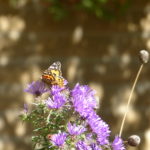
Fall wildflowers are an important food source for insects and birds.
Enjoy wildflowers. Asters, Goldenrods, and Maximilian Sunflowers are the very last blooms of the season. Their colors brighten the yard and provide nectar for insects and then seeds for migrating and overwintering birds. But all this comes with sadness as we know we’ll not see wildflowers again until next spring.
- Watch wildlife. It’s migration time and one of the best seasons for seeing unusual birds. We often look upward and sometimes spot pelicans and waterfowl winging high overhead. By now deer in their subdued winter coats are sleek and well fed on a diet of acorns. Bucks have polished their antlers. Chipmunks and squirrels scurry about caching winter food.
We’d like to hear what you enjoy about the Equinox time. Please email us your joys and projects in this wondrous season.



























